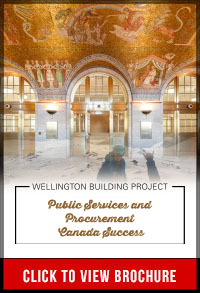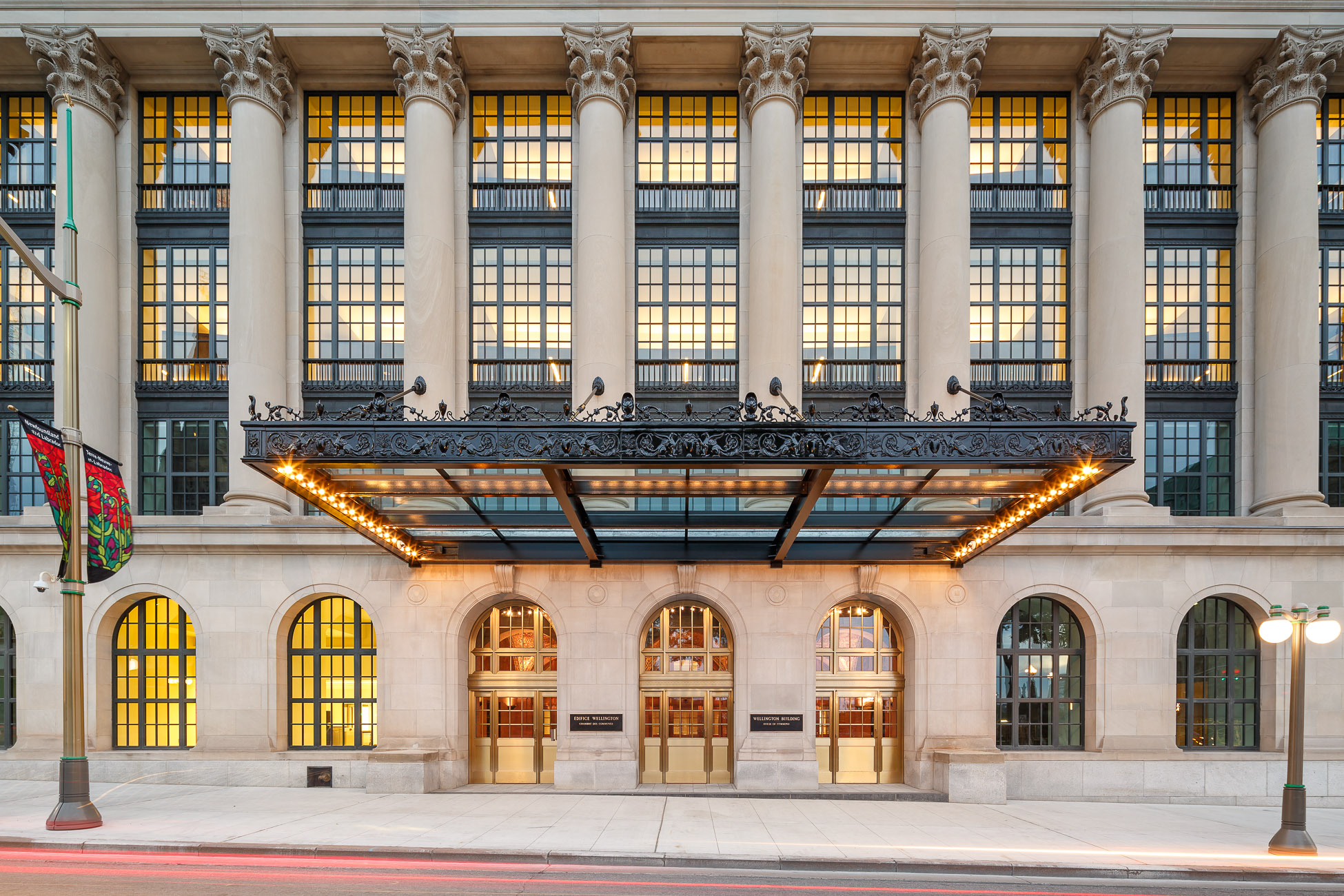PUBLIC SERVICES AND PROCUREMENT CANADA SUCCESS
By Anna Guy
From the outside, the new and improved Wellington Building looks as glamourous as it did when it originally opened in 1927—but the inside is 21st Century engineering and design at its finest.
 Tourists, politicians and Ottawa citizens have appreciated the historic Wellington building since it was built in 1927. Prominently located across from the West Block of the parliamentary buildings, and a shining example of Beaux Arts architecture, the Wellington Building helps form the tradition of architectural glory of the Capital Region. The six-storey heritage building was originally built in 1927 for the Metropolitan Insurance Company (MET Life), with an addition being added in 1959. Acquired by the Federal Government in 1973, the Wellington building was then home to the Canadian Postal Museum until, in 1984, a shortage of office space for the Members of Parliament (MPs) resulted in some of them being moved to the building—the first-time MPs had ever been housed outside of Parliament Hill.
Tourists, politicians and Ottawa citizens have appreciated the historic Wellington building since it was built in 1927. Prominently located across from the West Block of the parliamentary buildings, and a shining example of Beaux Arts architecture, the Wellington Building helps form the tradition of architectural glory of the Capital Region. The six-storey heritage building was originally built in 1927 for the Metropolitan Insurance Company (MET Life), with an addition being added in 1959. Acquired by the Federal Government in 1973, the Wellington building was then home to the Canadian Postal Museum until, in 1984, a shortage of office space for the Members of Parliament (MPs) resulted in some of them being moved to the building—the first-time MPs had ever been housed outside of Parliament Hill.
Designated as a classified heritage building in 1986, the building is part of the unique and splendid architectural mosaic in the capital region. In 2010, the Wellington Building was closed for an extensive rehabilitation project to modernize and restore the building. When doors opened in 2016, the Wellington Building became a permanent home for Members of Parliament and their staff.
Total Upgrade
Any project of this size and scope is a massive undertaking. This was made more complicated by the fact that the building was essentially divided into separate spaces by its previous additions. During the rehabilitation, all offices were closed down so the team of 400 workers and more than 100 contractors could get to work on everything from asbestos abatement and seismic reinforcement, to the modernization of its interior spaces and systems to accommodate MP offices, committee rooms, a library and supporting administrative spaces. The project was deemed one of the most successful—and green—initiatives of its kind, and will help leverage future projects of its kind.
Described as a “complex and complicated endeavor”, by Sylvain Lepage, Project Director at Public Services and Procurement Canada, the building at once retains its original splendour and design while being completely modernized on the interior.
“The aim of the project was to fully restore and renovate the building and to provide space for parliamentarians. We used innovative solutions to reduce energy consumption while preserving heritage elements,” says Lepage. “This was achieved by carrying out a full demolition of the building’s interior, abatement of hazardous substances, replacement of the mechanical and electrical systems, seismic reinforcement. It also required the installation of information technology systems and new escalators and elevators.”
“The envelope of the building remains unchanged,” says Lepage, adding that historic preservation work included the conservation and restoration of the building’s windows, doors and roof. “The renovation was not just a rehabilitation,” says Lepage. “We changed the function of this building from an administrative-type building to a parliamentary building, where we are providing space for 70 members of parliament and their staff as well as a number of committee rooms.”
Canada 150
While not specifically built as part of the Canada 150 initiative, the building will provide a wonderful backdrop to the planned festivities.
“The Wellington Building restoration and rehabilitation exemplifies the success in using existing Capital Region assets to meet the accommodation needs of the Parliament of Canada, while preserving Canadian heritage and leaving a legacy for future generations,” says Ezio DiMillo, Director General at Public Works and Government Services Canada.
“The government of Canada is committed to preserving these heritage buildings and our parliamentary buildings, which are in need of significant work,” says DiMillo. “We have achieved this goal [on this project], and continue to do that with the Sir John A. MacDonald Building, as well as the West Block and the Government Conference Centre (Ottawa’s former Union Station), and we will leverage lessons learned from delivering this project in future rehabilitation projects.”
“Most Unique” Mosaic
Of all the upgrading done on the interior, one significant heritage feature was left and restored—the dramatic Byzantine-style mosaic the lobby of the front entrance. Described as the “most unique and little known treasure” by David Monaghan, former Curator, Curatorial Services for the House of Commons, the mosaic’s main theme—commissioned by the MET Life, is the company as a protector and defender against illness, natural disaster and accident. “At destruction and famine, thou shalt laugh,” reads the mosaic, and “the Great Metropolitan Mother” would protect her policy-holders from images of the earthquakes, fires and floods.
Green Building
A 4-Green-Globes-certified project, the Wellington Building rehabilitation project aligned with the Government’s green initiative to reduce the environmental footprint through precedent-setting sustainable and energy efficient measures. According to Public Services and Procurement Canada, green initiatives included a green roof complete with a rainwater collection system to water the plants; solar panels to pre-heat hot water for the building; sensors which turn light on and off; a light well to harvest natural light and reduce artificial lighting costs; a green wall of plants to absorb carbon dioxide, dampen noise and to clean and humidify the air; air recovery units to recycle heat in the building to heat incoming air; and the reuse of the former masonry and marble work to reduce waste and reduce costs.
Perhaps most remarkably, of the 22,000 metric tons of material removed during the demolition, 98 per cent was recycled or reused and the building’s energy consumption has been reduced by 25 per cent.
The Wellington Building rehabilitation is a success on all fronts. Parliamentary functions are facilitated, and the public is appreciative. The Wellington Building’s design and engineering have been widely acknowledged, as indicated by the awarding of multiple accolades which include the Interiors Award for Historic Restoration from Contract Magazine, the Award of Excellence presented by the City of Ottawa, and the Award of Excellence in the category of Conservation: Architecture, presented by the Canadian Association of Heritage Professionals.
“We believe that project has been very successful,” says DiMillo. “We are quite proud of this wonderful building. The public reaction has been tremendous.”
For more information on procurement projects like this, please visit www.canada.ca/en/public-services-procurement.html
Consider visiting the Wellington Building during the Canada 150th celebrations. For more information, please visit, www.ottawa2017.ca






